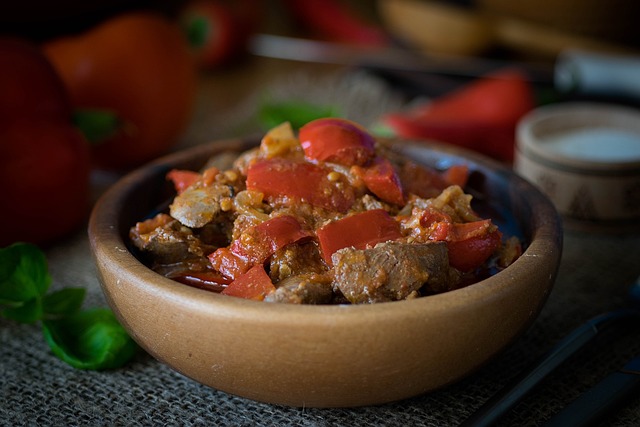Culinary Alchemy: Transforming Humble Ingredients into Gourmet Delights
Elevate your cooking game by mastering the art of culinary alchemy. Discover how to turn everyday ingredients into extraordinary dishes that will impress even the most discerning palates. From simple pantry staples to forgotten produce, we'll explore innovative techniques and flavor combinations that will revolutionize your approach to home cooking.

Unlocking the Potential of Pantry Staples
Your pantry is a treasure trove of culinary potential, waiting to be unleashed. Common items like canned beans, rice, and pasta can be transformed into gourmet dishes with a few clever techniques. For instance, try blending canned chickpeas with tahini, lemon juice, and garlic to create a silky smooth hummus that rivals any store-bought version. Or elevate plain rice by toasting it in butter before cooking, then infusing it with saffron and stock for a fragrant pilaf. Pasta can become a canvas for creativity – toss it with brown butter, sage, and toasted walnuts for a sophisticated twist on a simple comfort food. Even humble canned tomatoes can be transformed into a rich, complex sauce by slowly simmering them with aromatics and a splash of red wine. The key is to think beyond the obvious uses of these staples and experiment with different flavor combinations and cooking methods.
Vegetable Metamorphosis: From Bland to Grand
Vegetables often play second fiddle in many meals, but with the right approach, they can become the stars of the show. Take cauliflower, for example – roasting it whole with spices until golden and caramelized transforms it into a stunning centerpiece dish. Or consider the humble carrot – by slow-roasting it with honey and harissa, you can create a sweet and spicy side that’s both visually striking and delicious. Even oft-neglected vegetables like Brussels sprouts can be reinvented; try shredding them finely and quickly sautéing with pancetta and balsamic vinegar for a luxurious warm salad. The key to vegetable alchemy is understanding how different cooking methods can alter texture and concentrate flavors. Grilling, roasting, and caramelizing can all bring out the natural sweetness in vegetables, while techniques like pickling or fermenting can add complexity and depth to their flavor profiles.
Protein Alchemy: Elevating Meats and Plant-Based Options
Transforming proteins from ordinary to extraordinary is a hallmark of culinary alchemy. For meat eaters, this might involve slow-cooking tough cuts like beef brisket or pork shoulder until they’re meltingly tender, or using marinades and rubs to infuse flavor into lean cuts. Chicken thighs can be elevated by braising them in a rich sauce of wine, mushrooms, and herbs, creating a dish that’s far more than the sum of its parts. For those preferring plant-based options, tofu can be transformed from bland to bold by pressing it to remove excess moisture, then marinating and grilling for a smoky, flavorful result. Lentils, often overlooked, can be turned into luxurious patties or formed into “meatballs” with the addition of aromatic spices and binders. The key to protein alchemy is understanding how to build layers of flavor through techniques like marinating, braising, or smoking, and pairing proteins with complementary ingredients that enhance their natural qualities.
Sweet Transformations: Dessert Alchemy
Dessert is perhaps where culinary alchemy shines the brightest, turning simple ingredients into show-stopping finales. Consider the humble banana – when caramelized and flambéed with rum, it becomes the sophisticated Bananas Foster. Or take plain Greek yogurt and transform it into a luscious frozen treat by adding honey and your choice of flavors before freezing. Even day-old bread can be repurposed into a decadent bread pudding, soaked in a rich custard and studded with chocolate or fruit. The secret to dessert alchemy lies in understanding the chemical reactions that occur during baking and cooking. For instance, browning butter before adding it to cookie dough creates a deeper, nuttier flavor profile. Or using a touch of salt in sweet dishes can enhance and balance flavors, turning a simple chocolate mousse into a complex and sophisticated dessert. By mastering these techniques, you can create impressive desserts that belie their simple origins.
Culinary Alchemy Tips & Tricks
• Experiment with different cooking methods to unlock new flavors in familiar ingredients
• Use acids like lemon juice or vinegar to brighten and enhance flavors
• Incorporate umami-rich ingredients like miso or anchovies to add depth to dishes
• Toast spices before using them to intensify their aroma and flavor
• Learn to balance flavors by combining sweet, salty, sour, bitter, and umami elements
• Use herbs and spices creatively to transform simple dishes into exotic creations
• Master the art of caramelization to bring out natural sweetness in vegetables and meats
• Explore fermentation to add complexity to ordinary ingredients
• Don’t be afraid to combine unexpected ingredients – some of the best dishes come from experimentation
Culinary alchemy is more than just cooking; it’s about seeing the potential in every ingredient and having the creativity to bring out its best qualities. By mastering these techniques, you can transform your kitchen into a laboratory of flavors, where even the most humble ingredients can become the building blocks of extraordinary meals. Remember, the most important ingredient in culinary alchemy is your own imagination and willingness to experiment. So go forth and create – your next culinary masterpiece awaits!





